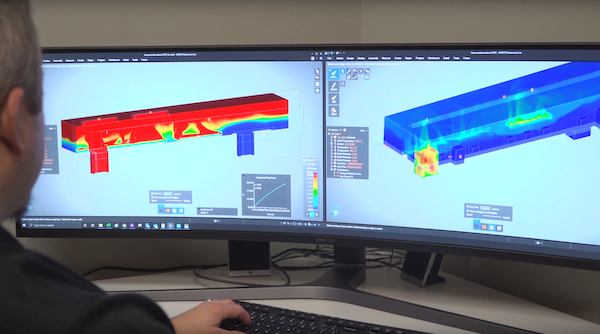Moffitt Streamlines Custom Vent Designs With Discovery Live
With ANSYS real-time simulation, customers can visualize natural ventilation solutions quickly, shortening design cycles and accelerating sales.

ANSYS Discovery Live enables faster design iteration for the Moffitt team. Image courtesy of ANSYS.
Latest News
October 16, 2019
When your product is all about natural air flow that’s invisible to the naked eye, it can be a tough sell to customers without the proper visualization tools. For decades, Moffitt, a manufacturer of natural ventilation solutions aimed at commercial and industrial facilities, sat down with customers using paper-based calculations and sketches to make a case for its unique method of cooling while collaborating in the design process.
As customers got more tech-savvy and expected more verifiable results, Moffitt’s engineering group began incorporating Computational Fluid Dynamics (CFD) simulation into its design and sales process. CFD, accessible as an extension to Moffitt’s existing Autodesk CAD platform, was used extensively to model the airflow, both to achieve an optimal venting solution and to help customers understand the natural cooling process by changing numbers on a page into 3D models.
“You can’t see airflow and that makes it difficult for customers to make decisions,” explains John Moffitt, the company’s president. “But when that’s related to colors on a page whether it be velocity or temperature, that gives customers a lot of power to understand what they’re getting and what the value of the system is. It helps them make decisions to achieve the results they are looking for with our [venting] applications.”
While Autodesk CFD helped customers get over the hump and get more visibility into the venting solutions, Moffitt’s use of simulation was limited due to the complexity and more importantly, because the modeling would tie up the engineering team’s workstations for hours, sometimes even days on end. “The modeling took forever and that was a sticky point for our engineering team,” says Mike Berry, the company’s director of engineering. “When several [modeling projects] hit at once, any other engineering task would grind to a halt. The process was not set up for iterative design.”
The inability to effectively iterate throughout the simulation process was another significant barrier. Typically, there is a lot of back and forth between the engineering and sales teams as well as with the customers for this type of product. With traditional CFD, models would have to run overnight or longer, and if a mesh turned out wrong, a simple tweak meant the whole process had to begin anew. “The real problem was modeling time—our sales team would be hoping for a one-week turnaround and we were barely hanging on with six, eight, or 10-week turnarounds,” Berry says. “It didn’t work for our customers—they needed answers more quickly.”
In fact, it was the speed of simulation that got Moffitt interested in ANSYS Discovery Live. Introduced to the real-time simulation platform through a third-party partner, Moffitt quickly began incorporating the tool into its design workflow. Now, instead of waiting hours or a day to see reasonable results, Discovery Live provides answers in real-time, allowing the team to find and address errors quickly as well as facilitating collaboration between engineering and sales partners.
“It’s helped us shrink the cycle,” Berry says. “We’re able to turn around designs that would have taken us weeks, in days,” Berry adds, saying the resulting workflow has helped the company win new orders.
Subscribe to our FREE magazine, FREE email newsletters or both!
Latest News
About the Author
Beth Stackpole is a contributing editor to Digital Engineering. Send e-mail about this article to [email protected].
Follow DE





